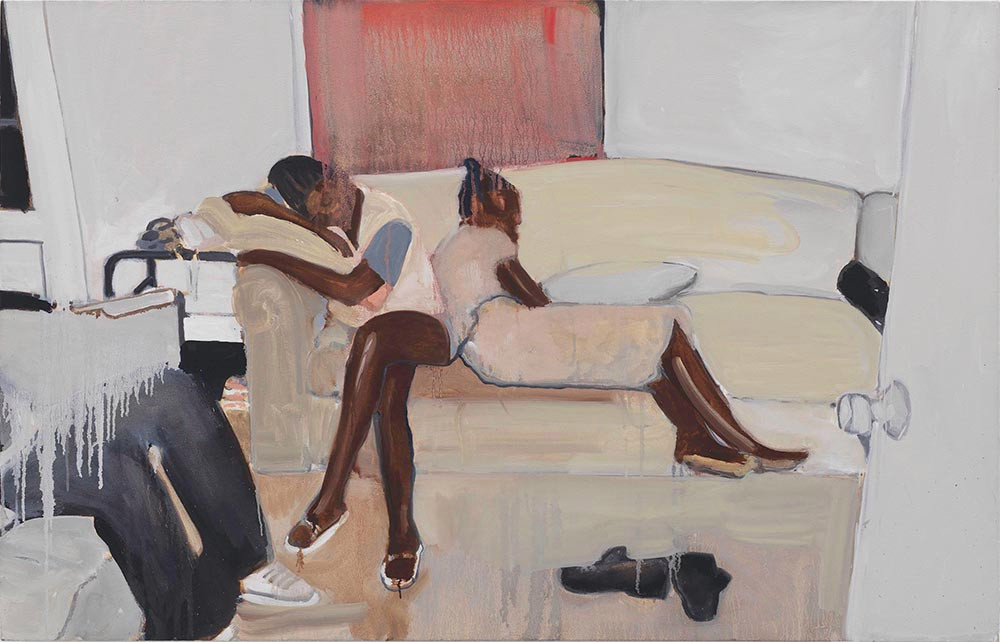[ad_1]
In 2013, painter Noah Davis founded the Underground Museum (UM) in Arlington Heights, Los Angeles, with his brother, Khalil Joseph, and his wife, Karon Davis. The three aimed to bring museum-quality shows to a historically underserved African American and Latinx neighborhood. Two years later, in August 2015, Davis died of a rare form of cancer at the age of thirty-two. Expertly organized by Helen Molesworth—former chief curator at the Museum of Contemporary Art, Los Angeles, and a friend of the artist—the recent exhibition at David Zwirner showcased a large selection of the enigmatic paintings Davis made between 2007 and 2015. A side gallery was furnished to pay homage to UM by evoking its back office: there were couches designed by the artist’s mother, works by Karon Davis, maquettes of the institution’s past exhibitions, and a presentation of BLKNWS (2018–19), a two-channel video work by Joseph that takes the form of a fictional news broadcast chronicling black excellence.
Davis’s paintings are weird, dark, and intoxicatingly beautiful—a range he hit with subtlety and ease. He used muted colors, diluted pigments, and washed-out drip marks to render black figures in surreal environments. Some works are soothing, such as Pueblo del Rio: Concerto (2014), a nocturnal scene of a figure playing a grand piano in the street outside a South Los Angeles housing project. Others seem like grim vignettes from psychological or science-fiction horror movies. Man with Alien and Shotgun (2008) depicts a man, shotgun in hand, holding a long gray fishlike creature, ostensibly dead after the hunt. The Last Barbeque (2008)—perhaps a reference to Margo Humphrey’s lithograph The Last Bar-B-Que (1989), which reinterprets the Last Supper as a gathering of people dressed in colorful African prints—appears to be a family portrait of sorts. Three figures stand together near a grill in the painting’s bottom right-hand corner. From a bush nearby, another trio of people, dressed formally, emerges ominously, as if they are ancestral spirits. A figure in the background is thrown backward as a plume of smoke rises before him: a chilling spectacle of a young man’s demise. Still other paintings are domestic and humdrum, save a few strange and dreamlike details. In an untitled work from 2015, two women rest on a beige couch. Nearby, another figure sits on a white sofa, torso cropped, lap obscured by an ambiguous dripping white form.
Davis was influenced by the films of Alfred Hitchcock and Roger Corman, as well as the writings of cult novelist Richard Brautigan, most notably the novel In Watermelon Sugar (1968), which tells the story of a building called iDEATH that houses a community after the fall of civilization. Davis dedicated his 2010 series “Forgotten Works” to Brautigan’s novel. One painting from it, The Summer House, was featured in the Zwirner show. It depicts a cottage in the distance, while in the foreground a figure gazes up at a silvery, abstract sculpture. In a 2013 interview with A.i.A., Davis called the world of his paintings his “own black countercultural dystopia”—a postapocalyptic landscape populated solely by black people. This future without whiteness is eerie and ethereal, but it also celebrates blackness in its totality.
Davis’s paintings are prescient and, in almost wizardly fashion, appear new, as if the pigments are fresh on the canvas. It’s hard to say if this was an effect of Molesworth’s arrangement of the works by palette rather than chronology, or if it’s simply a testament to the enduring nature of Davis’s art. In any case, the paintings transcend the elegiac tone and public praise that always accompany a posthumous show like this one. They offer something new and exciting at every turn.
This article appears under the title “Noah Davis” in the April 2020 issue, pp. 78–79.
[ad_2]
Source link


